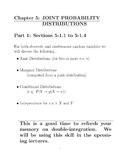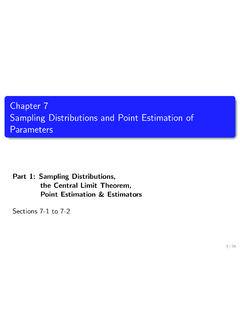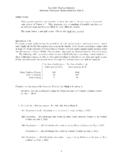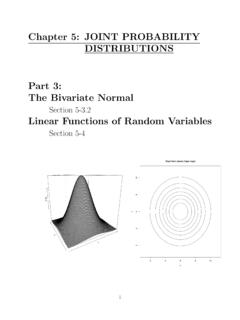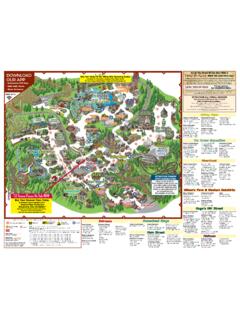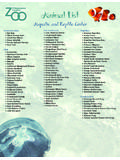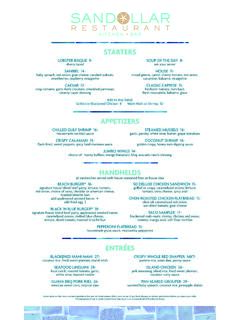Transcription of 2.1 Data: Types of Data and Levels of Measurement
1 1 Data: Types of Data and Levels of Measurement 2 Quantitative or Qualitative? ! Quantitative data consist of values representing counts or measurements " Variable: Year in school ! Qualitative (or non-numeric) data consist of values that can be placed into nonnumeric categories. " Variable: Political affiliation (rep, dem, ind) classFrequency1234010203040 Histogram of 'Year in School'3 Types of Data ! Quantitative " Numerical values representing counts or measures. " Something we can `measure with a tool or a scale or count. " We can compare these values on a number line. ! 2 pounds is less than 4 pounds " You can take a mathematical average of these values, can be used in computations. ! weight ! number of students in a class 4 Types of Data ! Qualitative (or non-numeric) " Non-numerical in nature (but could be `coded as a number, so be careful). ! low=1, med=2, high=3 (still qualitative) " Could be considered a label in some cases. ! Political affiliation (dem, rep, ind) !
2 Numbers on a baseball uniform " #90 isn t larger than #45 in the mathematical sense. They re just a label. ! ID (34B, 67AA, 19G, ..) ! Education level (HS, 2-yr, 4-yr, MS, PhD) 5 5 Types of Data ! Qualitative (or non-numeric) " Can t use meaningfully in a ! Can you take the average of the observed political affiliations? No, it s non-numerical. " Dem, Dem, Rep, Ind, Dem, ! ID #s 56, 213, 788,.. Average ID? no. " If variable is represented by numbers (as with IDs), ask yourself if an average makes if not, then it s qualitative not quantitative. 6 6 Types of Data ! Quantitative " Number of medals won by in a given year. ! Qualitative " Medal Type: Gold/ silver /Bronze Summer Olympic USA medalists 1896-2008 7 7 Types of Data ! Quantitative " Number of medals won by in a single year. ! Qualitative " Medal Type: Gold/ silver /Bronze " Summarized with a table or chart. Gold silver Bronze 2088 1195 1052 GoldSilverBronze050015002500 Gold silver Bronze 8 8 Types of Data !
3 Quantitative " Number of medals won by in a given year. " Can be shown with a distribution, or summarized with an average, etc. ! Qualitative " Medal Type: Gold/ silver /Bronze " Summarized with a table or chart. With some reformatting of the earlier data, we can get a count of medals for each year. Number of medals in a yearcount0100200300400A distribution. The x-axis shows part of the real-number line. Year Count 1896 20 1900 55 1904 394 1908 63 1912 101 1920 193 9 9 Types of Data ! Quantitative " Can be shown with a distribution, or summarized with an average, etc. " Commonly used summaries: ! Average value ! Maximum or Minimum value ! Standard deviation (a measure of spread of the data) " Summarizing a distribution with a single value can be very useful. " But be aware that averaging (or pooling, or aggregating) can potentially hide some interesting information (next slide). Number of medals in a yearcount0100200300400A distribution.
4 The x-axis shows part of the real-number line. Pooling (or Aggregating) Data 10 A Visual History of Which Countries Have Dominated the Summer Olympics, New York Times, Aug. 22, 2016 Tracing the rise and fall of each country s total medal count over All sports: Only diving: 11 Levels of Measurement for Qualitative Data ! Qualitative (two Levels of qualitative data) " Nominal level (by name) ! No natural ranking or ordering of the data exists. ! political affiliation (dem, rep, ind) " Ordinal level (by order) ! Provides an order, but can t get a precise mathematical difference between Levels . " heat (low, medium, high) " movie ratings (1-star, 2-star, etc.) # Watching two 2-star** movies isn t the same as watching one 4-star** movie (the math not relevant here). " Could be coded numerically, so again, be careful. 12 12 Levels of Measurement for Qualitative Data Political affiliation (dem, rep, ind) Nominal Level of pain (low, med, high) Ordinal Answer to survey: (strongly disagree, disagree, agree, strongly agree) Ordinal Eye color (blue, green, brown, etc.)
5 Nominal 13 13 Levels of Measurement (Another way to characterize data) Qualitative data is either Nominal or Ordinal (only 2 options) 14 Two kinds of Quantitative Data ! Continuous or Discrete? " Continuous ! Can take on any value in an interval ! Could have any number of decimals " weight, home value, height " , , , , etc. " Discrete ! Can take on only particular values " number of prerequisite courses (0, 1, 2, ..) " number of students in a course " shoe sizes (7, 7-1/2, 8, 8-1/2,..) 15 Levels of Measurement (Another way to characterize data) Quantitative data can be either Discrete or Continuous and either Interval or Ratio 16 Levels of Measurement for Quantitative Data ! Interval or Ratio? " Interval level ( differences or subtraction level) ! Intervals of equal length signify equal differences in the characteristic. " The difference in 90 and 100 Fahrenheit is the same as the difference between 80 and 90 Fahrenheit. ! Differences make sense, but ratios do not.
6 " 100 Fahrenheit is not twice as hot as 50 Fahrenheit. ! Occurs when a numerical scale does not have a true zero start point ( it has an arbitrary zero). " Zero does not signify an absence of the characteristic. " Does 0 Fahrenheit represent an absence of heat? ! Designates an equal-interval ordering. " 1 to 2 has the same meaning as 3 to 4. 17 Levels of Measurement for Quantitative Data ! Interval or Ratio? " Interval level ( differences or subtraction level) ! May initially look like a qualitative ordinal variable ( low, med, high), but Levels are quantitative in nature and the differences in Levels have consistent meaning. " Scale for evaluation: " If a change from 1 to 2 has the same strength as a 4 to 5, then we would call it an interval level Measurement (if not, then it s just an ordinal qualitative Measurement ). " To be an interval Measurement , each sequential difference should represent the same quantitative change. " But a 5 is not 5 times a 1 (ratios don t make sense here).
7 " This could have been on a 6 to 10 scale (arbitrary start). See comment on slide 20. 18 Levels of Measurement for Quantitative Data ! Interval or Ratio? " Interval level ( differences or subtraction level) ! IQ tests (interval scale). " We don t have meaning for a 0 IQ. " A 120 IQ is not twice as intelligent as a 60 IQ. ! Calendar years (interval scale). " An interval of one calendar year (2005 to 2006, 2014 to 2015) always has the same meaning. " But ratios of calendar years do not make sense because the choice of the year 0 is arbitrary and does not mean the beginning of time. " Calendar years are therefore at the interval level of Measurement . 19 Levels of Measurement for Quantitative Data ! Interval or Ratio? " Ratio level (even more meaning than interval level) ! At this level, both differences and ratios are meaningful. " Two 2 oz glasses of water IS equal to one 4 oz glass of water " 4 oz of water is twice as much as 2 oz of water. ! Occurs when scale does have a true zero start point.
8 " 0 oz of water is a true zero as it is empty, absence of water. ! Ratios involve division (or multiplication) rather than addition or subtraction. 20 Levels of Measurement for Quantitative Data ! Quantitative Interval level example " Temperature used to cook food*. A brownie recipe calls for the brownies to be cooked at 400 degrees for 30 minutes. Would the results be the same if you cooked them at 200 degrees for 60 minutes? How about at 800 degrees for 15 minutes? 200 degrees is not half as hot as 400 degrees. The ratio of temperatures does not make sense here. 21 Levels of Measurement for Quantitative Data ! Quantitative - Ratio level examples " Centimeters ! Difference of 40 cm (an interval) makes sense and has the same meaning anywhere along the scale. ! 10cm is twice as long as 5 cm (put two 5 cm items together and they are equivalent to 10 cm). Ratios make sense. ! 0cm truly represents no length or absence of length. " Mass " Length " Time 22 Likert scale (sometimes unclear) !
9 Is it Interval (Quantitative) or Ordinal (Qualitative) scale? " I think, most of the time, these surveys are just ordering responses lowest to highest and NOT fulfilling the interval scale requirements. " Difference of opinions on this though. Possible data Types and Levels of measure. 23 Possible data Types and Levels of measure. 24 As a statistician, the type of data that I have dictates the type of analysis I will perform. Dealing with Errors ! Types of errors: " Random vs. Systematic errors ! Size of Errors: " Absolute vs. Relative ! Describing Results: " Accuracy and Precision 25 Types of Errors ! Random errors: " Affects Measurement in an unpredictable manner ! Baby squirming on a scale ! may cause error above or below truth ! Introduces random noise to your Measurement ! Systematic errors: " Error that affects all measurements in a similar fashion ! Scale systematically weighs all babies a little too high (scale needs to be calibrated). 26 Types of Errors ! Random errors: " Just part of the process we have to deal with, sometimes called noise " We can measure object numerous times and take an average to reduce the effect of the random error !
10 Systematic errors: " We may be able to remove the error if the source can be detected ( recalibrating) " After data collected, can be corrected if error is detected and quantified. 27 Types of Errors 28 Picture (a) on the left represents a baby s motion, which introduces random errors to the Measurement process. Picture (b) on the right shows the scale reads pounds when empty, introducing a systematic error that makes all measurements pounds too high. Size of Errors 29 ! Consider a clerk that made a mistake and overcharged you $1. " What if you had just ! 1) A $1 piece of pie. ! 2) A $30,000 car. " Would you see the $1 discrepancy differently? ! Should we consider the mistake relative to the price? Size of Errors 30 ! 1) $1 overcharge on a $1 piece of pie: " Absolute value of overcharge: $ " Relative value of overcharge: or 100% ! 2) $1 overcharge on a $30,000 car: " Absolute value of overcharge: $ " Relative value of overcharge: or 11=1130000= of Errors 31 !
